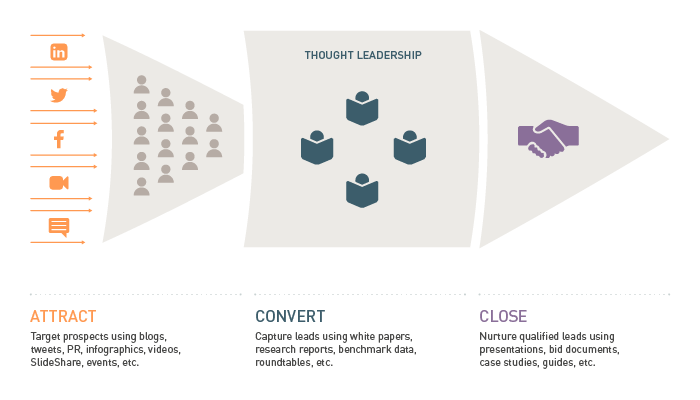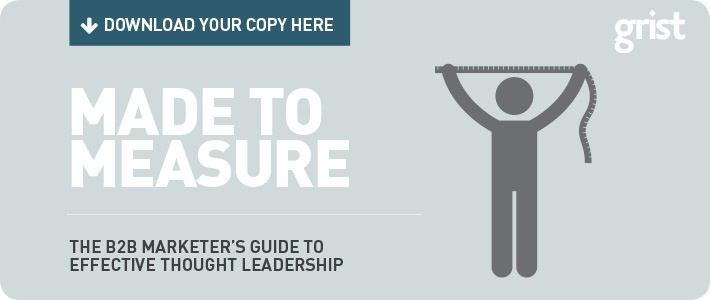“Far too often, for writers and editors, the story is done when you hit publish. At Huffington Post, the article begins its life when you hit publish.”
The words of Paul Berry, co-founder of HuffPost, could just as easily apply to B2B marketing.
Publishing the results of a B2B thought leadership survey is only the start of its journey. Exploiting its full potential demands a strategic and integrated campaign, designed to maximise its impact and longevity – and ultimately your ROI.
Our fourth blog in our series on B2B surveys looks at how to do this.
Flagship content
At the core of a survey-based campaign is a high-value, authoritative piece of thought leadership, published on your website – for example, a report, whitepaper, eBook or benchmarking tool.
This flagship content should communicate three things to your target audience:
- The headline results from your survey
- The opportunities that the results expose, which you can help businesses to exploit; and/or the threats you can help them to prepare for
- Expert advice on how to capitalise on the opportunities, and defend against the threats
The campaign begins
Allowing your new IP to languish on your website would waste the effort and resources you’ve invested so far. With your centrepiece content published, your integrated campaign can get underway in earnest.
At Grist, our approach to maximising the impact of B2B surveys is aligned to the three key phases of the customer decision journey.
We make sure that each content piece produced on the back of your survey has a clearly defined role in targeting and nurturing the audience. Each one must either:
- Draw prospects to the flagship content (attract)
- Turn them into qualified leads (convert)
- Nurture them through the sales pipeline (close)

Attracting prospects
The first phase of the campaign needs to grab the attention of your clients and prospects. There’s a whole range of ‘top-of-funnel’ activities that you can deploy at this stage, across the gamut of sales and marketing channels:
- sharing and promoting results on social media and other channels – via infographics, blogs, tweets, videos, SlideShare presentations, and so on
- promoting the highlights to existing contacts via e-newsletters
- conducting a PR campaign to promote the survey findings
- rolling out sector and/or regional results to extend the ‘Attract’ phase and enhance its momentum.
Whichever tactics you opt for, there’s one goal at this stage of the campaign: to engage and push prospective buyers to the high-value content on your website.
Converting prospects into leads
Having drawn prospects in, the next step is to convert them into sales leads. Gating the main content piece, and requesting email addresses in return for access to it, means you can capture the data you need to qualify and track leads.
Effective engagement activities at the ‘Convert’ stage also include events for clients and prospects. These might be roundtable sessions or webinars, where you can present and discuss the survey themes and results.
Additional content assets can be created from events and social feeds to refuel the ‘top-of-funnel’ activity stream.
Closing the sale
Convincing a web visitor to download some thought leadership content in return for their contact details is just the first stage in the convert and close process. But your survey results can also help lubricate the process of turning qualified leads into clients.
You can create valuable, insight-led sales enablement materials from your research findings to suit the exact needs of prospects wherever they are in the decision-making process. For example, data and insights from the survey can enhance bid documents, slide decks and bespoke sales presentations, by providing evidence to support your proposition. You can also create crib sheets for your sales teams. These should not only underline the survey results, but also suggest sales conversations that the findings can underpin.
A prospect who has downloaded multiple pieces of content such as case studies and how-to guides or visited pricing and product pages is demonstrating a clear intention to make a buying decision. The ultimate goal is convincing a qualified lead to fill out a form to say they want to be contacted by sales.
A campaign in action
Grist and our research partner Coleman Parkes have created a highly effective integrated marketing campaign on the theme of digital transformation for software firm CA Technologies.
Our case study explains how the survey-based engagement campaign helped CA to build its brand, generate leads and support sales activity.
We’ve helped many B2B brands like CA to realise the power of surveys as a content marketing tool and a source of competitive intelligence. We can help you to formulate a content marketing strategy that makes the most of your survey, and to design and produce the right content assets.
Please get in touch if you’d like to discuss how a survey could help make your campaigns more effective.



